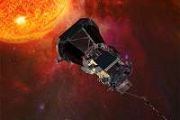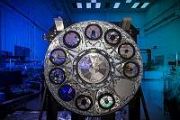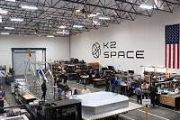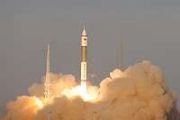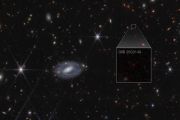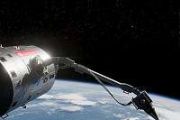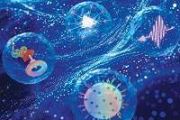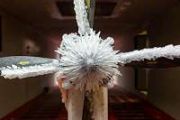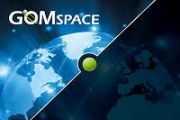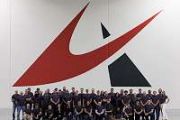
Copernical Team
DARPA, NGA transition novel optics technology to fieldable prototypes
 Materials with novel optical properties developed under DARPA's Extreme Optics and Imaging (EXTREME) program are providing new capabilities for government and military imaging systems. EXTREME, a basic research program in DARPA's Defense Sciences Office, successfully developed new optical components, devices, systems, architectures, and design tools using engineered optical materials, or metamat
Materials with novel optical properties developed under DARPA's Extreme Optics and Imaging (EXTREME) program are providing new capabilities for government and military imaging systems. EXTREME, a basic research program in DARPA's Defense Sciences Office, successfully developed new optical components, devices, systems, architectures, and design tools using engineered optical materials, or metamat Scientists spot rare neutrino signal for big physics finding
 Did you feel the trillions of neutrinos that just flew through your body? Probably not, because these subatomic particles rarely interact with matter. Neutrinos can travel through a lightyear's worth of lead without ever disturbing a single atom. Understanding these ghost-like particles could unlock mysteries of the universe, but how can scientists study neutrinos if they are seemingly undetecta
Did you feel the trillions of neutrinos that just flew through your body? Probably not, because these subatomic particles rarely interact with matter. Neutrinos can travel through a lightyear's worth of lead without ever disturbing a single atom. Understanding these ghost-like particles could unlock mysteries of the universe, but how can scientists study neutrinos if they are seemingly undetecta Scientists find strange black 'superionic ice' that could exist inside other planets
 Using the Advanced Photon Source, scientists have recreated the structure of ice formed at the center of planets like Neptune and Uranus.
Everyone knows about ice, liquid and vapor - but, depending on the conditions, water can actually form more than a dozen different structures. Scientists have now added a new phase to the list: superionic ice.
This type of ice forms at extremely hi
Using the Advanced Photon Source, scientists have recreated the structure of ice formed at the center of planets like Neptune and Uranus.
Everyone knows about ice, liquid and vapor - but, depending on the conditions, water can actually form more than a dozen different structures. Scientists have now added a new phase to the list: superionic ice.
This type of ice forms at extremely hi Science results offer first 3D view of Jupiter's atmosphere
 New findings from NASA's Juno probe orbiting Jupiter provide a fuller picture of how the planet's distinctive and colorful atmospheric features offer clues about the unseen processes below its clouds. The results highlight the inner workings of the belts and zones of clouds encircling Jupiter, as well as its polar cyclones and even the Great Red Spot.
Researchers published several papers o
New findings from NASA's Juno probe orbiting Jupiter provide a fuller picture of how the planet's distinctive and colorful atmospheric features offer clues about the unseen processes below its clouds. The results highlight the inner workings of the belts and zones of clouds encircling Jupiter, as well as its polar cyclones and even the Great Red Spot.
Researchers published several papers o Jupiter's Great Red Spot is deeper than thought, shaped like lens
 New studies of Jupiter's Great Red Spot released Thursday have found that while the meteorological phenomenon is deeper than originally thought, it's largely shaped like a flat lens about 10,000 miles wide.
The vortex storm, the largest of many such spots on Jupiter's surface, extends up to 310 miles below the planet's cloud tops, some 100 miles deeper than previous research indicated.
New studies of Jupiter's Great Red Spot released Thursday have found that while the meteorological phenomenon is deeper than originally thought, it's largely shaped like a flat lens about 10,000 miles wide.
The vortex storm, the largest of many such spots on Jupiter's surface, extends up to 310 miles below the planet's cloud tops, some 100 miles deeper than previous research indicated. Making space travel inclusive for all
 In a weightless, microgravity environment like space, what do ability and disability look like? How can someone with partial sight or impaired mobility navigate in a confined space like the space station? As scientists and innovators continue to push the boundaries of spaceflight and the possibility of human life on other planets, how can we build space infrastructure that is inclusive of all hu
In a weightless, microgravity environment like space, what do ability and disability look like? How can someone with partial sight or impaired mobility navigate in a confined space like the space station? As scientists and innovators continue to push the boundaries of spaceflight and the possibility of human life on other planets, how can we build space infrastructure that is inclusive of all hu Capabilities growth shows why US sees China as pacing challenge
 Army Gen. Mark A. Milley pointed to China's recent test of a hypersonic weapon system as an example of why the U.S. military is concerned about Chinese intentions.
The chairman of the Joint Chiefs of Staff spoke on Bloomberg News' David Rubenstein Show and said DOD officials saw the test as "a very significant event."
Pentagon Press Secretary John F. Kirby emphasized that China's dev
Army Gen. Mark A. Milley pointed to China's recent test of a hypersonic weapon system as an example of why the U.S. military is concerned about Chinese intentions.
The chairman of the Joint Chiefs of Staff spoke on Bloomberg News' David Rubenstein Show and said DOD officials saw the test as "a very significant event."
Pentagon Press Secretary John F. Kirby emphasized that China's dev Juno peers deep into Jupiter's colorful belts and zones
 Leicester study of data captured in orbit around Jupiter has revealed new insights into what's happening deep beneath the gas giant's distinctive and colourful bands.
Data from the microwave radiometer carried by NASA's Juno spacecraft shows that Jupiter's banded pattern extends deep below the clouds, and that the appearance of Jupiter's belts and zones inverts near the base of the water c
Leicester study of data captured in orbit around Jupiter has revealed new insights into what's happening deep beneath the gas giant's distinctive and colourful bands.
Data from the microwave radiometer carried by NASA's Juno spacecraft shows that Jupiter's banded pattern extends deep below the clouds, and that the appearance of Jupiter's belts and zones inverts near the base of the water c Satellite maker Terran Orbital strikes $1.58 billion SPAC Deal
 Tailwind Two Acquisition Corp and Terran Orbital Corporation have entered into a definitive business combination agreement. Upon the closing of the transaction, the combined company will operate as Terran Orbital Corporation, with plans to list on the NYSE under the symbol LLAP. The pro forma total enterprise value of the combined companies is approximately $1.58 billion. The transaction is expe
Tailwind Two Acquisition Corp and Terran Orbital Corporation have entered into a definitive business combination agreement. Upon the closing of the transaction, the combined company will operate as Terran Orbital Corporation, with plans to list on the NYSE under the symbol LLAP. The pro forma total enterprise value of the combined companies is approximately $1.58 billion. The transaction is expe Earth from Space: Glasgow

Glasgow, host of the 26th UN Climate Change Conference of Parties (COP26), is featured in this image captured by the Copernicus Sentinel-2 mission.






